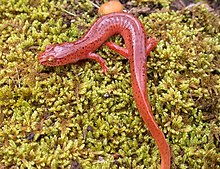| Spring salamander | |
|---|---|

| |
| Scientific classification | |
| Domain: | Eukaryota |
| Kingdom: | Animalia |
| Phylum: | Chordata |
| Class: | Amphibia |
| Order: | Urodela |
| Family: | Plethodontidae |
| Genus: | Gyrinophilus |
| Species: | G. porphyriticus
|
| Binomial name | |
| Gyrinophilus porphyriticus (Green, 1827)
| |

| |
| Range of Gyrinophilus porphyriticus subspecies: Brown: G. p. porphyriticus | |
| Synonyms | |
| |
The spring salamander (Gyrinophilus porphyriticus) is a species of salamander in the family Plethodontidae (lungless salamanders). It is found in Canada and the United States. The genus, Gyrinophilus, means "tadpole lover" and refers to the long period of time it spends as a gilled larva before maturing. The specific epithet, porphyriticus, is Latin from Greek, meaning the color of porphyry, a purple stone,[2] and this salamander has also been called the purple salamander.[3]
Its natural habitats are temperate forests, rivers, swamps, freshwater marshes, freshwater springs, inland karsts, and caves. In addition to insects, worms, and other small invertebrates, the fairly large spring salamander may also consume smaller stream dwelling salamanders such as two-lined and dusky salamanders. They are considered salamander specialists in some areas, such as the mountains of North Carolina, where between 40 and 50% of their adult diets may consist of other salamanders.[4]: 13 [5]
Although deforestation is a potential threat, the spring salamander occurs in many protected areas and is not listed as threatened in the IUCN Red List.[1]
- ^ a b IUCN SSC Amphibian Specialist Group (2022). "Gyrinophilus porphyriticus". IUCN Red List of Threatened Species. 2022: e.T59282A193373844. doi:10.2305/IUCN.UK.2022-1.RLTS.T59282A193373844.en. Retrieved 12 May 2023.
- ^ Mish, F.C., Editor in Chief (2004). Merriam-Webster's Collegiate Dictionary, 11th Edition. Springfield, Massachusetts: Merriam-Webster.
- ^ Conant, Roger (1975). A Field Guide to Reptiles and Amphibians of Eastern and Central North America, Second Edition. Boston: Houghton Mifflin.
- ^ Lidley, Brian A. (1999). Natural History of the Northern Spring Salamander Gyrinophilus porphyriticus porphyriticus at the Westvaco Wildlife and Ecosystem Research Forest in Randolph County, West Virginia (MSc). Marshall University. Paper 389 – via Marshall Digital Scholar.
- ^ Bruce, Richard C. (1979). "Evolution of Paedomorphosis in Salamanders of the Genus Gyrinophilus". Evolution. 33 (3): 998–10000. doi:10.2307/2407662. JSTOR 2407662. PMID 28568439.
